Japan
Wood Products Prices
Dollar Exchange Rates of 10th
May
2018
Japan Yen 1097.43
Reports From Japan
Consumer confidence drops to
eight month low
The Cabinet Office April survey suggested Japanese
consumers felt negative on economic prospects, the first
drop in two months. The consumer confidence index for
April dropped to an eight-month low of 43.6 from 44.3 in
March.
Japan's six-year economic recovery slowed in the first
quarter of this year as the pace of growth in exports
slipped while at home rising prices for everyday goods
began to worry consumers.
Analysts attribute the decline in the consumer confidence
to rising utility costs, higher fuel costs (which are
impacting home delivery and other service charges) and
the perception that food prices are rising while incomes
are stagnant.
The confidence sub-index for ¡®livelihood¡¯ also fell in April
and the index for income growth also dropped. In addition
there were noticeable declines in the indices for
willingness to buy durable goods and the employment
prospects.
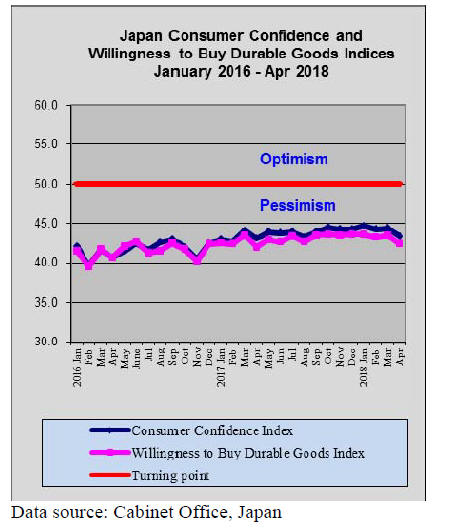
Changes in consumer behavior
An article from McKinsey & Company, an
American consulting firm with offices in Japan, says
Japanese consumers are now behaving more like their
counterparts in Europe and the United States.
Once noted for their willingness to pay for quality and
avoiding cheaper products, Japanese consumers are now
showing keen interest in discount and online bargains.
This shift in the attitudes and behavior of Japanese
consumers seems likely to persist, says the McKinsey
report, even if the economy recovers because of the rise
internet shopping across all age groups and the emergence
of a less materialistic younger generation.
This conclusion is borne out by trends in the furniture
market where off-shore manufactured low cost items are
capturing market share from the traditional ¡®last a life
time¡¯ furniture styles.
For the full article see;
https://www.mckinsey.com/industries/consumer-packagedgoods/
our-insights/the-new-japanese-consumer
Yen set to weaken further
The US dollar rallied against the yen in early May and
steadied at just over 109 yen per US dollar. This marked
the sixth consecutive week of yen depreciation due to the
rise in the dollar because of the hawkishness sentiment in
the US Federal Reserve.
Analysts say the outlook for the yen remains weak as the
US dollar¡¯s strength is likely to continue. All eyes are on
the upcoming meeting between Trump and Kim. If there
are signs that progress on denuclearisation on the Korean
Peninsula is possible then further dollar strength is
forecast.
Overall, say commentators, the yen looks set to extend its
depreciation to 110.0 against the US dollar. But this
depends on prospects for further interest rate hikes in the
US and the Bank of Japan maintaining its loose monetary
policy.
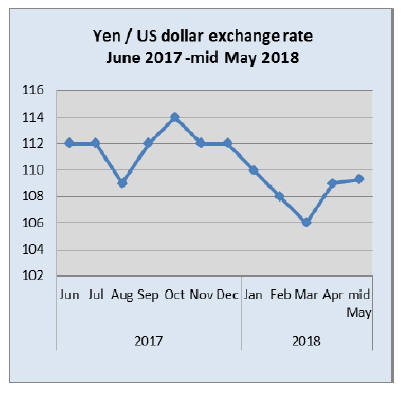
5-fold growth in smart home demand forecast
Interest in ¡®smart homes¡¯ is growing in Japan and a recent
report from Orbisresearch entitled ¡®Japan Smart Home
Industry Production, Sales and Consumption Status and
Prospects¡¯ says the smart home market in Japan could
grow almost fivefold by the year 2024.
The smart home system allows home owner to remotely
control and monitor different devices in the home such as
cooling, lighting, security and more. In Japan, there is a
demand for a safe and secure living environment,
especially concerning safety functionalities and discrete
monitoring for elderly people.
For more see: http://orbisresearch.com/contacts/requestsample/
2035854
Home builder grabs Global Environment Award
The Japanese house builder, Sekisui House, one of Japan's
largest homebuilders in the country was awarded the
Grand Prize during the April Annual Global Environment
Awards for its eco-friendly, anti-disaster ¡°Smart-
Community¡¯ Projects. Four other companies were
recognised for their environmental initiatives during the
award ceremony.
The Global Environment Award and Fujisankei
Communications Group FCG-sponsored Grand Prize has
been presented annually with the goal of recognising
businesses and other organizations for their innovations
and activities conducive to curbing global warming and
environmental conservation.
Sekisui House was rewarded for a range of work,
including its role in constructing energy self-sufficient,
disaster resilient ¡®smart communities¡¯ in 16 locations
across Japan.
See: https://japan-forward.com/sekisui-house-leads-globalenvironment-
awardees-2018/

Furniture imports
The value of Japan¡¯s February 2018 imports of wooden
office, kitchen and bedroom furniture was largely
unchanged from the previous month but significantly
higher than in February 2017.
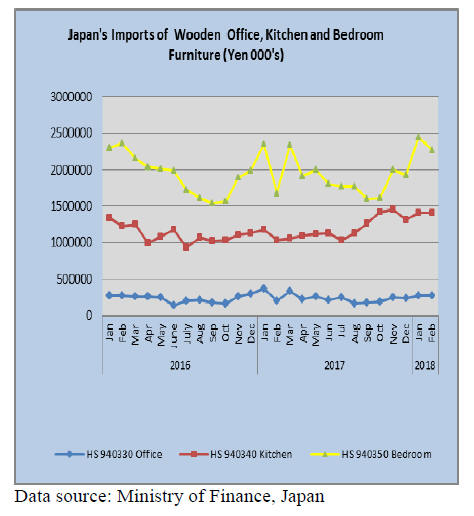
Compared to the value of imports in February 2017,
February 2018 import values for all three categories of
wooden furniture being tracked jumped over 30%. From
mid-2017 there has been a steady rise in the value of
furniture imports.
Office furniture imports (HS 940330)
August 2017 marked the low point in Japan¡¯s imports of
wooden office furniture (HS 940330). Since then imports
have risen steadily and only in February 2018 was there
the first signs of a slowdown as imports dropped about 1%
compared to January.
Year on year wooden office furniture imports in February
2018 were some 32% above the value of February 2017
imports. The top four shippers of wooden office furniture
(HS 940330) to Japan in February 2018 accounted for
almost 90% of all imports of this category of furniture.
China was the largest supplier at 74% of the total in
February followed by Taiwan P.o.C (5%), Poland (5%)
and the US (4%).
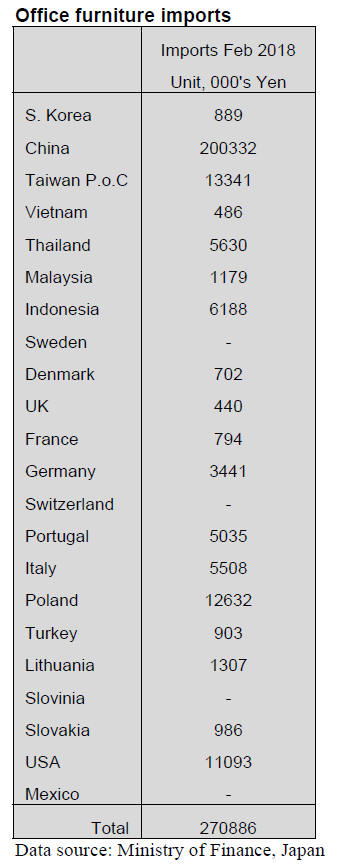
Kitchen furniture imports (HS 940340)
February imports of wooden kitchen furniture (HS
940340) were flat month on month but compared to a year
earlier February imports jumped 30%.
In February 2018 there was a sharp rise in Japan¡¯s imports
of wooden kitchen furniture from China (+55%) and a
25% rise in the value of imports from Italy. The other
main shippers, the Philippines and Vietnam say export
values drop.
The Philippines is emerging as the major supplier of
wooden bedroom furniture to Japan and in February 2018
topped the rank of suppliers being followed closely by
Vietnam.
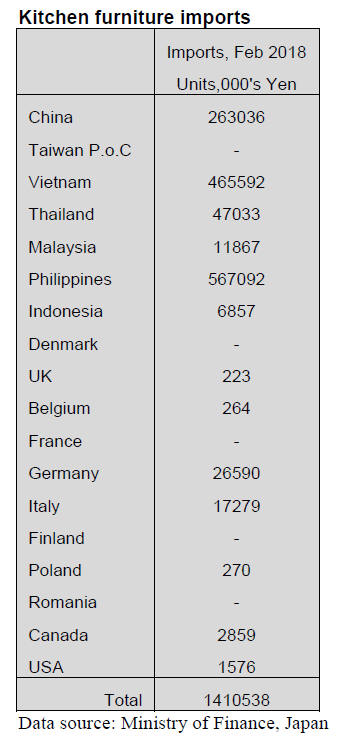
Bedroom furniture imports (HS 940350)
February marked a correction in the value of wooden
bedroom furniture imports with month on month imports
dropping 7.5%. However, year on year, February 2018
imports were 35% higher.
Two shippers account for over 90% of Japan¡¯s wooden
bedroom furniture imports, China (58%) and Vietnam
(33%) with the third ranked shipper, Thailand, only
managing around 4%.
In February this year shipments from China were flat and
shipments from Vietnam dropped 13% with most other
minor suppliers recording slightly lower shipments.
 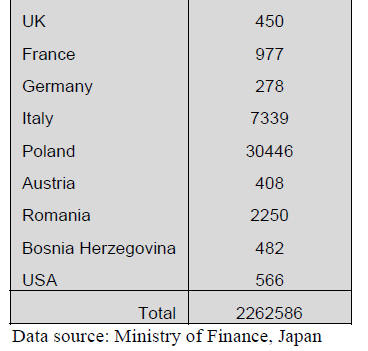
Trade news from the Japan Lumber Reports (JLR)
For the JLR report please see:
http://www.nmokuzai.
com/modules/general/index.php?id=7
Wood demand projections
The forestry Agency held wood demand projection
meeting for the second and third quarter of this year.
Generally demand for imported wood products would
decline for both logs and lumber while domestic logs for
lumber and plywood would increase. This would improve
self-sufficiency rate but may result in oversupply of
domestic logs.
Reflecting continuous decline of new housing starts
compared to the same month a year earlier, forecast of
new housing starts by 12 private think tanks is average of
953,000 units, 8,000 units lower than previous forecast.
Due to high export prices, import of North American logs
and lumber would decrease. Log supply for the second
quarter would improve so the import would increase by
2.4% but the third quarter import would decline by 4.5%
due to forest fires during summer months.
The demand for these quarters would stay unchanged from
2017. Actually the demand is more than the supply.
Supply of North American lumber would decline by 4.7%
for the second quarter and the third quarter supply volume
would stay the same as last year but the demand for the
second quarter would decline by 8.3% and for the third
quarter by 5.1% because of high export prices due to
overheated U.S. lumber market.
The supply is more than the demand so that the inventories
at the end of the third quarter would increase. European
lumber, which has increased for two straight years, would
keep decreasing all through 2018 as the supply side is
more interested in other markets and the prices in Japan
have climbed high enough.
Supply of both domestic and imported structural
laminated lumber for the second quarter would decline by
4.3 % and for the third quarter by 3.8%. Reasons are
continuous stagnation of whitewood products and
dropping orders for redwood beam as the demand has
peaked on imported products while domestic production
would stay almost the same as last year.
Radiata pine log supply declined while lumber supply
increased in 2017. In 2018, log supply would stay the
same as 2017 and lumber would increase slightly in 2018.
By higher prices of radiate pine lumber, the demand would
shift to lower cost domestic cedar lumber.
Russian log import would continue low through the third
quarter due to higher log export duty. Russian lumber
import increased by 10.4% in the first quarter but the
second quarter supply would be the same as 2017 then
drop by 9.1% for the third quarter. Reason is that other
markets are more attractive for the Russian suppliers.
Demand for domestic logs would keep increasing through
the third quarter. For lumber, the Forestry Agency made
policy to give subsidy for use of solid wood then new
plywood mill started in April.Also log export would
increase to all the market, particularly for China.
South Sea (tropical) logs and lumber
Rainy season in the South East Asian countries seems to
be over now and log production is recovering but it will
take quite some time to solve log shortage for local
plywood mills. With aggressive log purchase by India and
China, log prices would continue high.
Plywood mills in Japan are not able to pay any more high
prices for logs despite low log inventories while orders
rush in with declining supply of imported plywood. Log
prices of meranti regular are unchanged at 12,000 yen per
koku CIF.
Movement of South Sea lumber like free board has not
recovered yet in April but the market prices are high due
to high export prices and the suppliers are declining
supply.
Indonesian mercusii pine and Chinese red pine free board
prices are holding between 115,000-120,000 yen FOB
truck per cbm. There are plenty of inquiries on crating
lumber.
New plywood plant in Miye
Nisshin Group Ltd. (Tottori prefecture) completed
building a new plywood manufacturing plant in Miye
prefecture. It has started the production in April. This is
the first plywood plant in Kii peninsula, where has rich
forest resources.
Total investment is seven billion yen. Total employees are
about 50. The plant is fully automated to save man power.
Annual log consumption is 103,000 cbms at the beginning
and it will be expanded to 120,000 cbms in future.
Main producing item is non-structural panels like floor
base and coated concrete forming panel. Monthly plywood
production will be 6,000 cbms.
To secure logs stably, it has concluded an log purchase
agreement with local forest unions, log auction market and
timber owners. It will have three routes to collect cedar
and cypress logs from Miye prefecture log suppliers,
Nisshin will subsidize cost of replantation for timber
owners, who supply plywood logs by clear cutting.
Nisshin aims to make this plant as the most high
production plant in Japan.
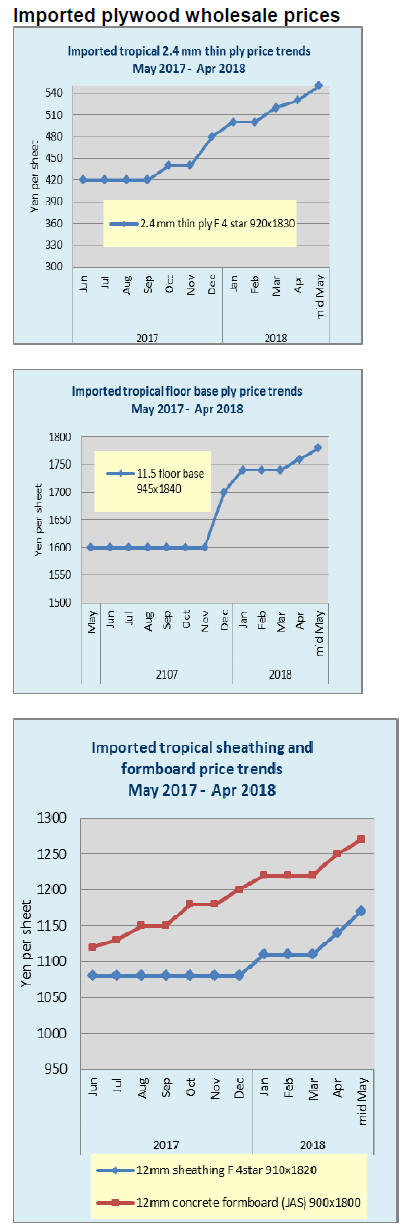
2017 review of laminated lumber
Total supply of both domestic and imported structural
laminated lumber in 2017 was 2,434,799 cbms, 11.1%
more than 2016. Domestic production was 1,567,000
cbms, 10.3% more and imports were 868,00 cbms, 12.5%
more. Both are the highest record.
New housing starts in 2017 were 0.2% less than 2016 but
the demand of laminated lumber grew higher than housing
starts.
Laminated beam lumber prices climbed steadily
supported by strong demand but laminated post prices
stagnated due to over -supply and competition with
domestic low priced cedar laminated post.
By size, small size was 745,300 cbms, 13.4% more,
medium size was 786,700 cbms , 8.7% more and large size
was 32,700 cbms, 10.2% less. Overlaid post was 2,300
cbms, 17.9% less.
While structural laminated lumber supply increased,
supply of laminated lumber for interior has decreased for
four consecutive years with 120,000 cbms, 7.0% less.
Domestic production for both structural and interior was
1,687,000 cbms, 8.9% more, which was 0.6% more than
2006¡¯ record high volume.
Source of raw materials of domestic production was 67%
of European, 26% of domestic and 6% of North American.
Compared to 2016, European increased by 1 point and
North American decreased by 3 point then domestic
increase by 2 points.Rough estimate in volume is,
European was 1,130,290 cbms, 10.5% more than 2016 or
108,000 cbms.
Domestic was 439,000 cbms, 18.0% more or 67,000 cbms.
North American was 101,000 cbms, 27.4% less or 38,000
cbms. North American declined because of higher export
prices and domestic increase was result of higher
production of cedar laminated post.
In total supply of structural laminated lumber, small size
was 1,242,531 cbms, 12.4% more, medium size was
1,155,961 cbms, 10.5% more and large size was 37,400
cbms, 9.2% less.
Domestic share was 64.4%, 0.4 pointless. By size, small
was 60.0%, 0.5 points more. Medium was 68.1%, 1.0
pointless. Large was 96.2%, 1.0 pointless.
Domestic production of small size has increased for two
straight years with 745,300 cbms, 13.4% more. Compared
to 2015, it was 24.2% more. With imported small size,
total supply was 1,242,531 cbms, 12.4% more, which was
more than past record of 1,137,501 cbms in 2013.
The most notable change of small size is rapid expansion
of laminated cedar post production.
Total production of domestic laminated lumber increased
by 18.0% or 66,788 cbms in volume. Two companies of
Chugoku Lumber and Kyowa Lumber increased
production of cedar laminated post by about 70,000 cbms,
which is almost the same as increase volume in total
supply.
Since small size production includes sill, purlin and girder
besides post, it is hard to estimate percentage of post but in
laminated post, 40% may be domestic cedar laminated
post.
In any rate, more than 20% of total supply of small size is
domestic species of cedar, cypress and larch. Cost of
domestic cedar laminated post would be 50,000-53,000
yen per cbm delivered, which is equivalent to 1,650-1,750
yen per piece. Cost of whitewood laminated post has been
1,850-1,900 yen all through 2017.
While prices of other members like sill and beam have
kept climbing, house builders shifted to lower cost cedar
post to reduce overall cost. However, it is doubtful if cedar
laminated post manufacturers make money when the
prices are lower than solid wood KD cedar post. Cedar
laminates post prices used to be higher than whitewood
laminated post.
Price drop to present level is result of competition among
the manufacturers, not by competition with whitewood
laminated post. Meantime, whitewood lamina cost in the
fourth quarter of 2016 was Euro 243-248 per cbm C&F
then it climbed to Euro 255-260 in the fourth quarter 2017.
Euro 12 increase in one year.
With weaker yen, the yen cost rose from 33,000 yen per
cbm FOB truck port yard to 39,000 yen, 6,000 yen
increase. Therefore, there is no winner in terms of
profitability for cedar laminated post and whitewood
laminated post.
European made whitewood laminated post prices also
climbed so the importers were not able to pass higher cost
onto sales prices in stagnant market so they lost money.
Import of small size in 2017 was 497,231 cbms, 11.1%
more than 2016. This is two consecutive years¡¯ increase.
Imported value was 25,863 million yen, 24.2% more than
2016 so average cost rose from 46,534 yen per cbm in
2016 to 52,014 yen in 2017,11.8% or 5,480 yen but
market prices in Japan has not changed much due to
oversupply and competition with cedar post.
Fluctuation of exchange rate of Euro changed the cost
month after month from low of 1,850 yen per piece in
spring to high of 1,950 yen in summer.
European lamina cost seems to keep climbing this year as
demand is strong in Europe and other markets particularly
U.S.A. while demand in Japan seems to be lower than last
year so if high level supply continues like last year, price
hike would be much harder than last year.
On medium size, domestic production was 786,700 cbms,
8.7% more than 2016. Imported medium size increased by
14.3% so total supply of medium size was 1,155,961
cbms, 10.5% more. Since imports increased more than
domestic, share of domestic is down by 1.0 point at
68.1%.
Volume of beam and girder in one unit of house is
estimated about 1.7 times more than post but supply of
medium is lower than small size so share of medium size
laminated lumber is still low.
Beam competition is between redwood laminated beam
and solid wood KD Douglas fir lumber as compared to
post competition is between laminated whitewood and
laminated cedar.Shifting from solid wood to laminated
beam is going faster.
Inquiries on laminated beam was much stronger than solid
wood beam last year so that the prices of redwood
laminated beam climbed smoothly last year. Redwood
lamina export prices in the fourth quarter 2016 were Euro
240-245 per cbm C&F then it rose to Euro 270 for the
fourth quarter 2017 so redwood lamina prices climbed
higher than whitewood lamina.
Imported yen cost climbed from 32,000 yen per cbm to
40,500 yen, 8,500 yen up in one year. Cost of imported
redwood beam rose from 55,000-56,000 yen in the fourth
quarter 2016 to 64,000 yen in fourth quarter 2017, 8,000-
9,000 yen increase in one year.
Domestic manufacturers increased the sales prices since
last July. The prices of domestic made laminated beam
were 56,000 yen per cbm delivered until June. They rose
to 58,000 yen in July then 60,000 yen in September. In
January this year the prices are 63,000 yen.
Competing Douglas fir solid wood KD beam prices were
raised twice late last year by total of 4,000 yen because of
higher log prices, which help pushing laminated beam
prices up higher. Price increase of laminated beam is
smaller than Douglas fir KD beam.
Despite rapid price increase, there is no negative reaction
so laminated beam should have solid demand. Higher
prices of finished product support purchasing power of
redwood lamina.
Medium size laminated lumber import in 2017 was
369,261 cbms, 14.3% more. Share of imports was 31.9%,
1.0 point up. Total value of imports was 19,438 million
yen so the average unit price was 52,641 yen per cbm, up
by 5,875 yen or 12.6%.
Export prices of redwood laminated lumber were Euro 430
at the fourth quarter 2016, which rose to Euro 450 at the
fourth quarter 2017.
Supply capacity of medium size from Europe has been
expanding. Finland has been leading supply country. It
shipped 123,000 cbms in 2013 then increased to 217,000
cbms in 2017. Share of Finland is 59%. Estonia, Rumania
and Germany follow Finland. Plan to increase the
production continues in Europe so the supply will increase
in 2018 as long as Japan pays competitive prices.
|